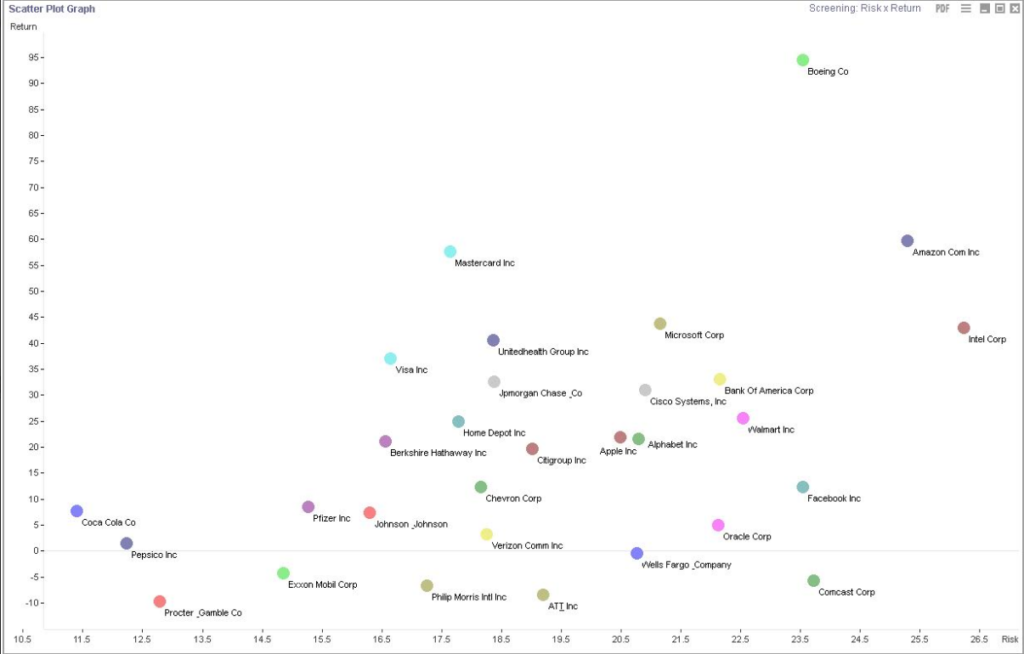

In investing, risk and return are highly correlated and increased potential returns on investments usually go hand-in-hand with increased risk.
To highlight the impact risk-return analysis on large cap equities we ranked the top 30 companies by market cap and, using the Economatica system, we calculated their 1year risk return profiles and generated a scatter plot chart to visualize the results.
In the table below, the companies are ranked by market cap, from highest to lowest. 24 stocks have had positive 1 year returns, 6 have had negative 1 year returns, 8 companies are listed on NASDAQ, and the remaining 22 other companies are listed on the NYSE. In terms of risk, 12 companies’ risk profile is greater than 20, and two of these are greater than 25 ( Amazon and Intel Corp)
The three companies with the highest 1 year returns are: Boeing (94.56%), Amazon (59.66%), and Mastercard (57.64). The 1 year risk for these companies are 23.74%, 25.49%, and 17.84%, respectively.
The three companies with the lowest 1 year returns are: Proctor & Gamble (-9.7%), AT&T (-8.43%), and Philip Morris (-6.6%). And, the 1 year risk for these companies are 12.97%, 19.39%, and 17.45%, respectively.

The analysis of risk-return is perhaps best depicted in a scatter plot chart as you can easily see which companies pose the least amount of risk (and usually lower returns) and those with the greatest amount of risk (and usually higher returns).
For example, the two companies with the least amount of risk are Coca-Cola and Pepsico, 11.6% and 12.42% respectively. In contrast, Boeing, Amazon, and Intel have the highest measure of risk. The majority of companies with positive 1 year returns are banded by Pfizer on the lower end of the risk spectrum and Facebook on the higher end.
For those six companies with negative 1 year returns the company with the greatest amount of risk is Comcast: 23.94% risk for a -5.67% 1 year return.

These 30 stocks can be divided into 19 sectors. You can easily conduct the same risk-return analysis using sector aggregates, or in this instance, breaking down the 30 large cap companies participating in this report.
In the table below, nine sectors have two or more companies participating, while the remaining ten sectors are represented by a single company.

Now, for the sake of comparative analysis and portfolio diversification, you can infer from the scatter plot chart below, which sectors you may wish to examine deeper to identify companies whose risk-return profile make for a potentially better investment. What other Aerospace manufacturers have less risk, which Depository Credit Intermediation companies offer higher returns for slightly more risk, or which Telecoms have positive returns, for example.
The Economatica system offers a range of sophisticated analytic tools and financial data on an easy to use online research platform that empowers asset managers, analysts, and other investment professionals to help you identify and examine potential opportunities. Ask us for a free trial today and learn how to make your own observations such as these.
In this edition of Value Reports we examined the IPO market in the 1st half...
In this edition of Value Reports, we explore the Top 25 foreign stocks ranked by...
Using the Economatica system we calculated the EV/EBITDA (TTM) multiple for key sectors in the...